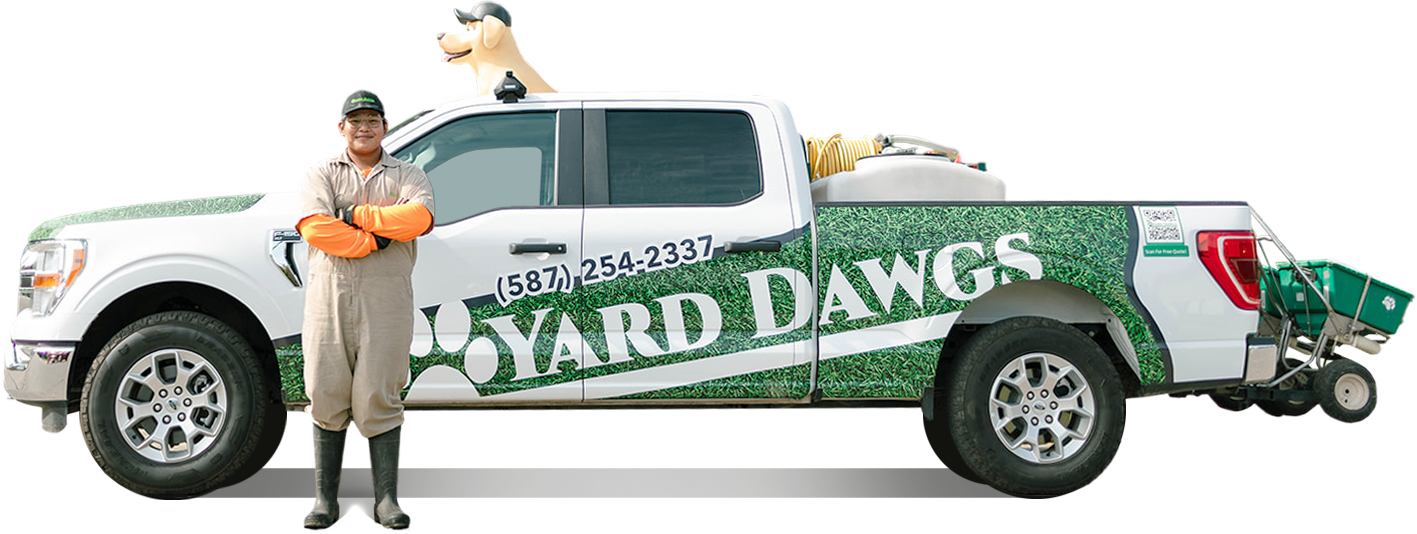While there are many different types of grassy weeds, these four are most prominently found on your lawn. One of the main challenges of working with grassy weeds is that they all share very similar characteristics to regular turf grass. This means the first step in successfully getting rid of grassy weeds in Canada is proper identification.

The Importance Of Tackling Grassy Weeds
Grass weeds, including quack grass, crabgrass, bluegrass and nutsedge compromise your soil's integrity, decreasing the availability of nutrients and ultimately leading to an unhealthy, nutrient-poor soil that is susceptible to more weed invasion. Even though these grassy weeds may not look threatening, failing to treat them right away can damage your lawn indefinitely.
Grassy weeds are different from other weeds as they are a C3, instead of a C4 plant. This changes the way they perform photosynthesis, or the way they extract nutrients from their environment. This means that they are ultra-competitive and will do anything to survive and thrive on your lawn.
Identifying The Difference Between Grassy Weeds And Turf Grass
Grassy weeds, thanks to their ultra-competitive nature often grow at a much faster rate than turf grass. If you notice a certain area of your lawn is growing faster than the rest, this area could be grassy weeds.
Grassy weeds are typically slightly wider than turf grass, and may grow in a characteristic star pattern, with new shoots sprouting from the middle. Some grassy weeds may also produce small, flowering heads that are not produced with turf grass. Grassy weeds may also make part of your lawn appear discolored, as turf grass has a consistent color while grassy weeds can have yellow to blue tinges in color.
Follow the rest of this guide to understand what type of grassy weed you have, and the difference compared to grassy turf.
Quack Grass
.png?width=740&name=Blog%20Photos%20(31).png)
What Is Quack Grass?
Quack grass is a cool season grass and therefore very common in Canada. It’s very common amongst farmers and is estimated to effect up to 50% of farmland. It can spread by seed and by the root system, a mature plant can yield up to 25 seeds.
It’s extremely important to pull quack grass as soon as you notice it and pull out the white root system as well. Quack grass grows at a speed of 2.5cm per day.
Traits Of Quack Grass:
-
Mature plants are very tall - reaching up to 3 feet
- White root system in the soil
- Long tapered blades at the end
- May have a bluish-green tint with small, fibrous hairs
How to Get Rid of Quack Grass Without Killing Your Lawn
Knowing how to get rid of quackgrass without damaging your lawn is crucial. The most effective approach is consistent manual removal and strengthening your lawn's health. For more aggressive control, consider a quackgrass killer designed for spot treatment. However, be cautious—some quack grass killer products are non-selective and can harm surrounding grass.
Crabgrass
.png?width=740&name=Blog%20Photos%20(32).png)
What is Crabgrass?
Crabgrass is a common grassy weed. Using a crabgrass killer in Canada can help reduce its spread over time. Crabgrass primarily spreads by seed, so the ultimate goal in management of crabgrass is seed control. By reducing the viable seed supply, it will decrease the ability of the seeds to establish themselves year after year after year. It is also important to note that crabgrass cannot be eliminated in one season, and requires the establishment of a healthy, thick turf grass to outcompete the weed.
Traits Of Crabgrass:
-
Leaf blades are usually 1/4 inch thick, much thicker than turf grass
-
Grow in a star-shaped pattern, with new shoots growing from the middle
-
Will send out solons, or "crab legs" to acquire more territory
Annual Bluegrass
.png?width=740&name=Blog%20Photos%20(33).png)
What Is Annual Bluegrass?
Annual bluegrass is a common perennial grassy weed. The weed is adapted to cool-seasons and well-watered sites. Annual bluegrass is able to resist low-mowing heights of <1 inch. This perennial grassy weed typically starts to germinate in late summer/fall when temperatures fall below 21 degrees C and will continue to germinate throughout the winter months.
Identifying Traits Of Annual Bluegrass:
-
Leaf blades have characteristics "boat-shaped" tips
-
White, fuzzy seed heads typically appear in spring
-
Mature plants may grow up to 12 inches tall
Nutsedge
.png?width=740&name=Blog%20Photos%20(34).png)
What Is Nutsedge?
Nutsedge is not a grass, but classifies as a sedge. Due to its similar identifying characteristics and weed management control, it is often grouped with grassy weeds. This perennial plant reproduces by tubers that are often found in the top 6 inches of soil. The tuber must be removed to control weed growth; therefore, it is recommended to hand-pull the weed once every 2-3 weeks to starve the tuber nutrient supply.
Identifying Traits Of Nutsedge:
-
Often thicker & stiffer than turf grass
-
Produces light brown "wheat looking" flowers with seeds
-
Blades are arranged in a trio at the base of the plant, and then grows in sets of two
5 Best Steps You Can Take To Stop The Spread Of Grassy Weeds
1. Pull Out Any Current Grassy Weed Before It Spreads
Grassy weeds start to germinate around 13 degrees Celsius, especially when it’s been that temperature for 5 days straight. It’s important to catch grassy weeds early on as some of them, especially crabgrass, can spread up to 150,000 seeds.
Note: Pull weeds once every 2-3 weeks to starve the nutrient supply
2. Aerate And Overseed Twice Per Year
A healthy and thick lawn is the best defense in preventing grassy weeds. The thinner the lawn is, then less shade your soil gets, and since grassy weeds thrive in warm soil temperatures. A thick lawn provides good shade for the soil and keeps the soil temperatures cool, which prevents grassy weed germination. Additionally, a thick lawn will choke out and out-compete any other unwanted vegetation; including grassy weeds but not limited to broadleaf weeds as well.
3. Always Keep Your Lawn Cut Above 2.5”
The longer the grass is, the more shade it will give to the soil. If you scalp your lawn too short (less than 2.5”) that can create multiple problems including grass weeds and having your lawn burning out. Keep your mowing height between 2.5” and 3.5” for best results.
4. Fertilize Regularly And Keep Weeds Under Control
Once again, the best defense against weeds in general is having a healthy and thick lawn. The regular maintenance and yearly fertilization and weed control is crucial to keeping your grass healthy. Not fertilizing for one year can cause major lawn damage if not addressed.
5. Water Infrequently But Heavily
The best practice for a healthy lawn is to water 2-3 times a week, but water for longer periods. The average lawn needs one inch of water per week. It’s better to do a half-inch watering session twice per week then ten periods of 1/10 inch watering sessions.
Pre-Emergent Strategy for Grassy Weeds in Canada
While pre-emergent herbicide Canada options like prodiamine are not widely registered, Canadians can still adopt a preventative approach. Although prodiamine is not commercially accessible, aeration, overseeding, and maintaining a dense lawn can replicate its weed-suppressing effect.
Can I Just Use A Herbicide Against Grassy Weeds?
In the United States, pre-emergent herbicides—which prevent grassy weeds by targeting seeds and roots before they sprout—are commonly approved for use. However, products like prodiamine (often sold under the brand name Barricade) are not registered in Canada, meaning lawn care companies do not have access to them.
In Canada, effective weed management requires a proactive and aggressive approach. The best defense is a thick, healthy, and lush lawn, which naturally crowds out weeds by increasing competition for space and nutrients.
While there isn’t a one-size-fits-all solution for grassy weed control, there are several strategies you can start implementing today.
- If quackgrass is growing outside your lawn, you can apply a vegetation killer such as RoundUp or concentrated vinegar.
- If it's inside your lawn, be cautious—these products will kill any grass they touch. You'll need a more selective approach to avoid damaging your turf.
Although pre-emergents like prodiamine are restricted in Canada, homeowners still have access to selective post-emergent herbicides. For example:
- Quinclorac is effective against crabgrass.
- Targeted sedge killers can help control nutsedge.
If you're searching for the best weed killer in Canada, look for selective herbicides that won’t harm your turfgrass.
Need help choosing the right solution? Our lawn care specialists can recommend safe and effective products—including quackgrass killers and nutsedge control options—tailored to your specific lawn needs. Contact us today to create a custom weed control plan.








.png)









